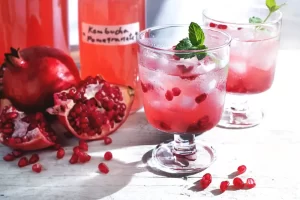
How To Make Kombucha Tea At Home – Easy Homemade Recipe With Scoby
- April 09, 2025
- by
- Shanaya
Kombucha is well known for its delicious taste and high nutritional value. Beyond the traditional flavor, kombucha is often infused with various fruits to create unique taste combinations. There’s nothing more exciting than brewing your own delicious and nutritious kombucha, right? In previous blog, I shared with you the health benefits of drinking kombucha tea. Today, we’ll learn how to make kombucha tea at home.
What Are the Main Ingredients of Kombucha?
The standard recipe for homemade kombucha drink includes a combination of green or black tea, organic sugar, and a SCOBY (Symbiotic Culture of Bacteria and Yeast). The mixture ferments for one to two weeks, after which the SCOBY is removed, leaving behind the finished kombucha tea.
Alternatively, you can use different types of tea, such as herbal tea, and various natural sweeteners (but avoid artificial sweeteners and sugar-free substitutes). A 2020 study found that different tea types can alter the microbial composition and properties of kombucha.
You may also like Amazing benefits of green tea
How to Make Kombucha Tea at Home – A Delicious and Nutritious Fermented Tea
To make kombucha tea at home, combine brewed tea with sugar and a SCOBY, let it ferment for 7–10 days, then flavor with fruit or herbs if desired.
Ingredients for Making Kombucha Tea
For Scoby
- 800g pineapple (peeled, eyes removed)
- 150ml beer
- 150g sugar
- 5 liters of boiled, cooled water
For Kombucha
- 1 Scoby culture
- 10g black tea (or green tea)
- 100g sugar
- 1 liter of water
Tools
- Juicer
- Glass jar
- Clean cloth
- Wooden spoon, etc.
Step-By-Step Recipe For Kombucha Drink
How To Grow A Scoby: Steps to grown your own scoby
- Step 1: Extract pineapple juice using a juicer or blend the pineapple and strain out the pulp.
- Step 2: Pour the pineapple juice into a clean glass jar along with 1.5 liters of boiled, cooled water, 150g sugar, and 150ml beer. Stir with a wooden spoon until the sugar dissolves.
- Step 3: Cover the jar with a clean cloth and secure it with a string. Place the jar in a cool, undisturbed area. After about 3–5 days, a thin film will form on the surface and gradually grow—this is the Scoby. You can let it grow for a few more days to thicken before using.
- Step 4: Once the Scoby is ready, seal the jar lightly and let it sit for about a month to produce vinegar. This vinegar can be used to cultivate new Scoby cultures.
Important Note:
A healthy Scoby should have an off-white color, a smooth and intact surface. If it turns dark, grayish, or develops mold spots, it has been contaminated and should not be used.
Once you have a Scoby, you can start making kombucha right away. Here’s how to make kombucha tea.
You may also like to discover Homemade beer face masks
Kombucha Brewing Instructions – Kombucha Fermentation Stages
- Step 1: Rinse the Scoby lightly with filtered water.
- Step 2: Add 10g of black tea to a jar, pour in 200ml of boiling water, and steep for 10 minutes. Strain out the tea leaves using a sieve or clean cloth.
- Step 3: Pour the brewed tea into a glass jar with 100g sugar, then add 800ml of filtered water. Stir well with a wooden spoon.
- Step 4: Gently place the Scoby into the jar and cover the mouth of the jar with a thin, clean cloth. Store in a cool, shaded place, away from direct sunlight.
How to store kombucha
- After 7–10 days, taste the tea to see if it has reached the desired sourness. Once ready, strain the liquid—this is your first fermentation kombucha (F1 kombucha).
- F1 kombucha can be bottled and stored in the refrigerator for gradual use. You can also enjoy it over ice or mix it with fruit juice for extra flavor.
Tips to Make Best Homemade Kombucha Tea
- Use fresh ingredients. Always choose fresh fruits, herbs, and spices for the best flavor.
- Monitor fermentation. Taste your kombucha regularly during the second fermentation to achieve the desired flavor.
- Store properly. Keep kombucha in a cool, dark place during fermentation and refrigerate it once it’s ready to stop the fermentation process.
- You should use black or green tea. Avoid other flavored teas like jasmine, lotus, or peach tea, because their scent compounds may interfere with Scoby development.
- The type of sugar will affect the color and taste of kombucha. Pick up palm or rock sugar, molasses, or raw sugar instead of refined white sugar.
- All equipment, including jars and spoons, is thoroughly sterilized and completely dry before use. Glass and wooden tools are preferable over metal.
A glass of kombucha has a mild sweet-sour taste, a fruity aroma, and a slight fizz, making it a refreshing and enjoyable drink. Give it a try, and you’ll surely love it! Happy brewing!
Preparing your own kombucha in the home is a creative and enjoyable process in which you are able to create a refreshing, delicious, and healthy beverage that’s tailored to your taste. Working with this step-by-step tutorial for making kombucha tea or through this recipe for homemade kombucha tea, you can experiment with ingredients, monitor the fermentation process, and brew up a unique drink that’s just as enjoyable to make as it is to drink. What are you waiting for? Let’s gather your jars, round up ingredients, and brew your way toward a healthier, tastier existence! Start enjoying your kombucha tea DIY.
In below section, we’ll discover some recipes for homemade kombucha tea with fruits. Are you ready to prepare your own drink with favorite fruit flavor to enjoy kombucha tea benefits for gut health? Here we go.
How to Flavor Kombucha After First Fermentation (F2 Kombucha)
Once you ferment the kombucha with different fruit juices, it becomes a distinct and cool drink. Just add some ice cubes and an appropriate quantity of fruit-flavored kombucha. You’ll have the pleasant smell of tea coupled with the specific smell of fruits. The flavor is equally well balanced between sour and sweet depending upon the kind of fruit juice used for fermentation, e.g., watermelon, pineapple, or apple. This is certainly a soothing drink to relax you after a long, exhausting day!
Combining Kombucha with Fruits, and Juice (Fruit-Infused Kombucha)
To create flavored kombucha (F2 kombucha), you can follow two methods:
Approach 1:
- Choose fruits like apples, pineapple, peach, lychee, strawberries, blueberries, or raspberries. Wash and drain.
- Cut larger fruits like apples, pineapple, and strawberries into small pieces. Keep smaller berries whole or lightly crush them.
- Divide the fruit into small bottles, then pour kombucha over it in a ratio of 20g fruit to 300ml tea.
- Seal the bottles and leave them in a cool place for 2 days to continue fermentation.
Approach 2:
- Choose your preferred fruits and juice them.
- Mix the juice with kombucha at a 1:2 ratio.
- Seal the bottle and leave it out for 2 days for a second fermentation.
- To serve, pour kombucha over ice and enjoy.
What is the difference between F1 and F2 kombucha?
| Feature | F1 Kombucha (First Fermentation) | F2 Kombucha (Second Fermentation) |
|---|---|---|
| Definition | Tea + sugar + SCOBY fermented for 7–10 days | F1 kombucha + fruit/herbs fermented 2–5 days |
| Main Purpose | Create the base kombucha with probiotics | Add flavor and carbonation (if sealed) |
| Flavor | Lightly sweet and tangy | Fruitier, more flavorful, sometimes fizzy |
| Fermentation Time | 7–10 days | 2–5 days (can be longer based on taste) |
| Carbonation | Very low or none | Yes, if bottled tightly during F2 |
| SCOBY Needed? | Yes | No (uses tea from F1) |
| Common Add-ins | None (just tea and sugar) | Fruits, herbs, juices (e.g., lemon, ginger, berries) |
| Storage | Room temp during fermentation, refrigerate after | Room temp during F2, refrigerate after to stop fermentation |
| Final Use | Can be consumed directly or used for F2 | Ready-to-drink, flavored kombucha |
Best Kombucha Flavoring Ideas
Kombucha comes in many popular variations. Among these, lemon kombucha is widely favored due to its familiar, refreshing taste. It’s also easier to drink compared to the ginger version. Besides, lemons are rich in vitamin C, vitamin B6, potassium, folic acid (vitamin B9), and flavonoids. Particularly, limonene, a compound found in lemons, effectively supports the liver’s detoxification process.
You may also like Impressive benefits of lemon water and Healing power of ginger honey
Lemon Kombucha Cocktail Recipe
 Kombucha is naturally carbonated with a low alcohol content. Consequently, it becomes a great base for cocktails. Below is a fermented tea recipe for a lemon kombucha cocktail.
Kombucha is naturally carbonated with a low alcohol content. Consequently, it becomes a great base for cocktails. Below is a fermented tea recipe for a lemon kombucha cocktail.
Ingredients
- 2–3 mint leaves (stems removed)
- 6 fresh strawberries (hulled and sliced)
- 15ml fresh lemon juice
- 60ml vodka or rum
- 180ml kombucha
- Sparkling water
- Ice cubes
Preparation
- Add mint leaves, strawberries, and lemon juice to a glass. Gently muddle them together.
- Pour in 60ml of vodka and 180ml of kombucha.
- Add ice to fill the glass, then top up with sparkling water.
- Garnish with fresh mint leaves and strawberries for a vibrant look.
Lemon Kombucha Recipe
Contrary to the first fermented tea recipe, this way is simpler and quicker to prepare kombucha tea with only lemon.
Ingredients:
- 2 cups of homemade Kombucha
- 2 fresh lemons
- 1 cup of water
- 1 tablespoon of sugar
How to make kombucha at home with lemon:
- Squeeze the juice from 2 lemons and pour it into the prepared Kombucha tea.
- Dissolve 1 tablespoon of sugar in a small bowl with water, then add this mixture to the lemon-Kombucha blend from Step 1. Pour everything into a bottle.
- Store the bottle at room temperature for 3 days, opening the cap daily to release carbon dioxide pressure. Taste it each day to check the flavor.
- Refrigerate and enjoy!
Lemon Ginger Kombucha
 Another recipe for homemade kombucha that you must try is with lemon and ginger.
Another recipe for homemade kombucha that you must try is with lemon and ginger.
Ingredients
- 100ml kombucha tea
- 1 small piece of ginger
- 1 lemon
- 4-5 teaspoons of sugar or honey (adjust to taste)
How to make Kombucha tea with lemon-ginger
- Peel and crush the ginger. Slice the lemon into thin rounds.
- In a large jar, mix the kombucha tea with the crushed ginger and lemon slices.
- If you prefer a sweeter taste, add sugar and stir well.
- If using honey, add it after mixing the lemon and kombucha.
- Seal the jar and shake gently to blend the kombucha, ginger, and lemon flavors.
- Infuse the tea. Place the jar in the fridge and let it chill for at least 1-2 hours to allow the flavors to infuse.
- Once chilled, pour the tea into a glass and add ice if desired. Enjoy your refreshing lemon-ginger kombucha!
Fresh Peach Kombucha
 Ingredients
Ingredients
- 200ml of fermented kombucha tea
- 1 fresh peach, peeled and chopped into small pieces
- 1 liter of chlorine-free warm water
- 8-10g of black tea bags
- 100g sugar
Steps to prepare flavored kombucha tea with peach
- Boil water and dissolve the sugar in it. Turn off the heat and steep the black tea bags for about 5 minutes.
- Remove the tea bags and allow the tea to cool to room temperature. Avoid using hot tea as it may kill the beneficial bacteria in kombucha.
- Pour the fermented kombucha tea into a non-metallic container. Add the chopped peach and seal the container.
- Store in a warm, undisturbed place for 7-10 days at a room temperature of around 20-25°C (68-77°F).
- Once fermented, enjoy immediately or refrigerate to stop fermentation. Shake before drinking to mix the flavors.
Best Fruit Flavors for Homemade Kombucha Recipes
How to Make Apple Kombucha
 Ingredients
Ingredients
- 4 black tea bags
- 200g sugar
- 1 liter of warm water
- 1 fresh apple, thinly sliced
- 1 kombucha SCOBY (fermentation culture)
Instructions
- Brew tea with hot water for 10 minutes, then remove the tea bags.
- Dissolve sugar in the tea and let it cool to room temperature.
- Pour the tea into a clean fermentation jar and add the apple slices.
- Place the kombucha SCOBY on top and cover the jar with a cloth.
- Ferment at room temperature for 7-14 days until it reaches the desired tanginess.
- Refrigerate before drinking and garnish with fresh apple slices. Enjoy your fermented tea recipe!
Kombucha Recipe with Pomegranate
 You will need:
You will need:
- 2-3 black tea bags
- 100g sugar
- 1 liter of warm water
- 200ml of kombucha starter
- 500ml fresh pomegranate juice
- Fresh pomegranate seeds (optional)
Steps to prepare pomegranate kombucha tea:
- Steep the black tea bags in warm water for 10 minutes, then remove the tea bags.
- Dissolve sugar in the warm tea and let it cool completely.
- Pour the cooled tea into a fermentation jar containing kombucha starter.
- Seal the jar and let it ferment at room temperature for 7-10 days.
- Once fermented, add fresh pomegranate juice and seeds. Seal and refrigerate for 1-2 days before drinking.
You may also like Health benefits of pomegranate
How to Make Grape Kombucha
 Ingredients
Ingredients
- 1 liter of chlorine-free warm water
- 2 black tea bags
- 100g sugar
- 200ml kombucha tea
- ½ cup fresh grapes
Steps to prepare kombucha recipe with grapes
- Boil 500ml water, dissolve the sugar, and let it cool.
- Brew the tea bags in the remaining 500ml water for 5-10 minutes.
- Once cooled, mix the sweetened water and tea together.
- Add the kombucha tea and pour the mixture into a fermentation jar.
- Add the grapes, ensuring they are clean.
- Cover the jar with a cloth and ferment at room temperature.
- After about 9 days, taste the kombucha. If it’s still too sweet, allow more time to ferment.
- Once fermented to your liking, remove the grapes and refrigerate.
You may also like DIY AHA face masks with grapes and other fruits
Key Points While Making Homemade Kombucha Recipes with Fruits
While kombucha tea has a lot of health benefits for gut health, some key points to remember are:
- Make sure all the ingredients and utensils are clean to prevent contamination.
- Keep kombucha properly stored to avoid over-fermentation.
- Indulge in your homemade kombucha for a healthy and refreshing beverage!
- Don’t let children have it too often in a day. If given, give it diluted with water.
- Pregnant women must not drink it because the fermentation process yields approximately 1% alcohol content.
- Diabetics must ask their physician whether to consume or not consume kombucha.
- High levels of lactic acid are found in the tea, which, if taken regularly over a period of time, can cause sinus infection, arthritis pain, and dizziness.
- Prolonged menstrual bleeding women must discontinue consuming it at least seven days prior to their menstrual cycle.
- Kombucha cultures spoil and become useless if not brewed correctly.
- Both lemon-flavored kombucha and kombucha tea in general have numerous health benefits. Nevertheless, for chronic diseases, there isn’t a final conclusion yet. For best results, always brew and prepare using the right methods.
Conclusion
Embarking on the journey of how to make kombucha tea at home is enjoyable and rewarding, with the ability to make a beverage that not only tastes great but also contains a high amount of probiotics. With these DIY kombucha recipes, you can taste fermentation and find your own unique blend to enjoy. From classic fermented tea recipes to experimenting with different fruits and herbs when flavoring your kombucha, the possibilities are endless. So grab your SCOBY and start brewing—your taste buds will thank you for the healthy and tasty ride! Happy fermenting and enjoy kombucha tea benefits for gut health!
Want more natural healthy recipes? Bookmark my page or follow me on Facebook page for daily DIY health and beauty tips.
You may also like:
Kombucha FAQs for Home Brewing
How long does it take to make kombucha?
About 7–10 days for the first fermentation and 2–3 days for flavoring (second fermentation).
Can I reuse my SCOBY?
Yes! After each batch, you can reuse it or share it with friends.
How long F1/F2 kombucha lasts in the fridge?
Home-brewed kombucha (both first and second ferment) can last in the refrigerator for at least 1-3 months. Its taste, however, becomes increasingly sour and less sweet over time.
What to do if your kombucha smells bad or mold forms?
Immediately discard the entire batch, including the SCOBY and liquid, as it is unsafe to consume.
How to reuse SCOBY or store SCOBY for future use?
Store the SCOBY in a glass jar with sweet tea or a sweet tea-kombucha mix. Cover it with a breathable cloth, and kept at room temperature.









